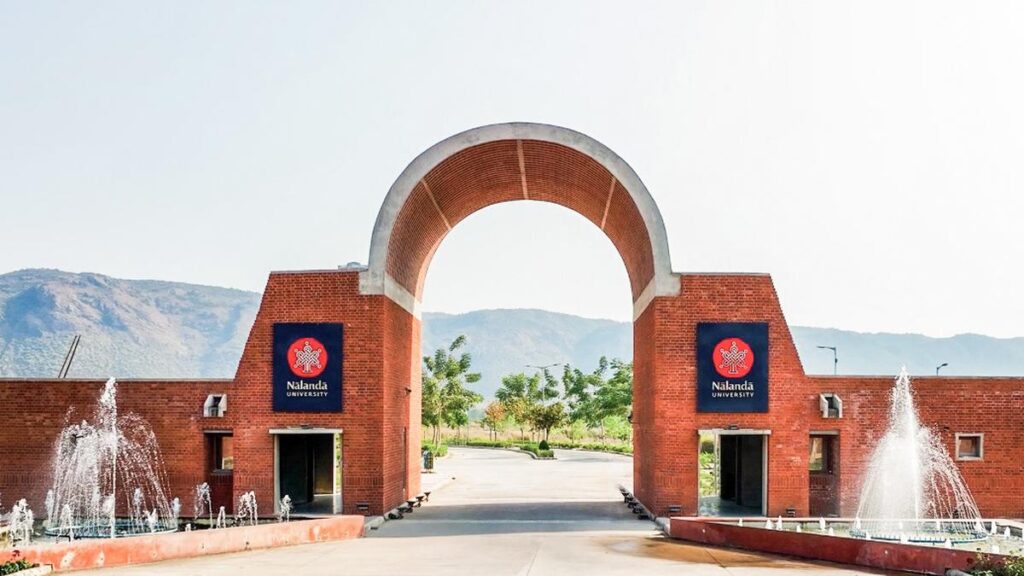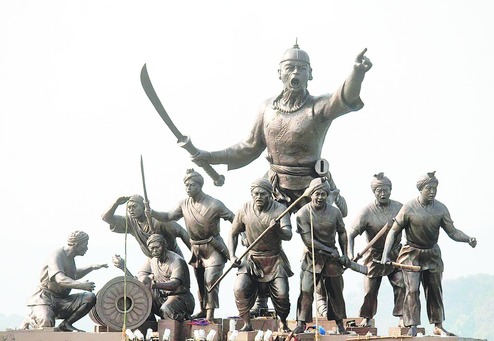Founding of Nalanda University:
Nalanda University was founded during the Gupta dynasty under the patronage of Emperor Kumaragupta I in the early 5th century CE, around 427 CE. It became one of the world’s first residential universities, offering a wide range of subjects, including theology, grammar, logic, astronomy, and medicine. Scholars from various countries, such as China, Korea, Japan, Tibet, Mongolia, Turkey, Sri Lanka, and Southeast Asia, traveled to Nalanda to study and teach.
Scholars of Nalanda University:
Over some 750 years, Nalanda’s faculty included some of the most revered scholars of Mahayana Buddhism. The faculty and students associated with the monastery included Aryabhata, Harsha, Dharmapala, Nagarjuna, Dharmakirti, Asanga, Vasubandhu, Chandrakirti, Xuanzang, and Silabhadra.
Attacks on Nalanda University:
1. First Attack (c. 450 CE):
The first recorded attack on Nalanda University occurred during the reign of Mihirakula, a Huna king. Although the details are sparse, it is believed that this invasion caused significant damage but did not lead to the university’s complete destruction.
2. Second Attack (7th Century):
The second destruction came during the 7th century by the Goudas. This time, the Buddhist king Harshavardhana then restored the university.
3. Third Attack (1193 CE):
The most devastating attack was carried out by Bakhtiyar Khilji, a Turkish military general. He destroyed the university, burning its extensive library, which was said to house millions of manuscripts. This attack effectively ended the university’s operation. According to accounts, the library burned for several months, with some sources claiming it burned for three months, while others suggest it could have lasted for up to six months.
Revival of Nalanda University:
In recent times, the idea of reviving Nalanda University gained momentum. In 2010, the Indian Parliament passed the Nalanda University Act, leading to the establishment of a new campus. The revival was inspired by the historical significance and global influence of the original university.
Key Proponents in the Revival:
1. Dr. A.P.J. Abdul Kalam: The idea of reviving Nalanda University was significantly championed by Dr. A.P.J. Abdul Kalam, former President of India. He envisioned Nalanda as an institution that could once again serve as a bridge between the East and the West.
2. Dr. Manmohan Singh: The initiative to revive Nalanda University was backed by the Indian government during Dr. Manmohan Singh’s tenure as Prime Minister. His administration provided political support and facilitated international cooperation for the project.
3. Professor Amartya Sen: A Nobel laureate in Economics, Amartya Sen chaired the Nalanda Mentor Group (NMG). He was instrumental in shaping the academic vision and institutional framework of the revived university. His international stature helped garner global support and resources for the university.
Inauguration of the New Nalanda University Campus:

On June 19, 2024, Prime Minister Narendra Modi inaugurated the new campus of Nalanda University in Rajgir, Bihar. This modern campus, spanning 455 acres, is designed as a ‘Net Zero’ Green Campus, featuring sustainable infrastructure such as solar power plants and water recycling systems. The new campus aims to honor the legacy of Nalanda by promoting international collaboration and offering advanced educational programs.
The inauguration was a landmark event, attended by various dignitaries, including Nitish Kumar, External Affairs Minister S. Jaishankar and ambassadors from 17 nations. PM Modi emphasized Nalanda’s historical importance and its role in promoting global cultural exchange and academic excellence.
Reflecting on Nalanda’s Ideals and Legacy
Nalanda University, nestled in the ancient land of Magadha (modern-day Bihar, India), transcends time and space. Its legacy reverberates across centuries, touching the hearts and minds of seekers, scholars, and dreamers alike. Here’s why Nalanda remains eternally relevant:
- Quest for Knowledge:
- Nalanda epitomized the pursuit of wisdom. Its hallowed halls echoed with debates, discussions, and the rustle of palm leaves inscribed with profound teachings.
- Today, as we navigate a complex world, Nalanda’s spirit reminds us to seek knowledge relentlessly, to question, and to explore beyond boundaries.
- Interconnectedness:
- Nalanda was a melting pot of cultures, languages, and ideas. Scholars from distant lands converged here, sharing insights and unraveling mysteries.
- In our globalized era, Nalanda’s legacy encourages cross-cultural dialogue, fostering understanding and unity amidst diversity.
- Holistic Education:
- Nalanda wasn’t merely about textbooks and exams. It nurtured the mind, body, and spirit.
- As we build modern educational institutions, let’s remember Nalanda’s holistic approach—where character, ethics, and empathy were as vital as academic prowess.
- Teacher-Student Bond:
- The guru-shishya tradition thrived at Nalanda. Teachers were revered, and students imbibed not only knowledge but also values.
- Today, honoring our educators and cherishing mentorship echoes Nalanda’s ethos.
- Resilience Amidst Challenges:
- Nalanda faced invasions, yet it rose like a phoenix. Its resilience inspires us during adversity.
- As we tackle global crises, let’s draw strength from Nalanda’s unwavering spirit.
- Revival and Continuity:
- The revival of Nalanda University symbolizes hope. It bridges ancient wisdom with modern aspirations.
- We stand on the shoulders of Nalanda’s giants, entrusted with safeguarding their legacy. The honor lies in nurturing this flame of enlightenment.
FAQ’s
Q. What is Nalanda University?
A: Nalanda University was an ancient center of learning in India, dating back to the 5th century CE. It was a renowned Buddhist monastery and a seat of learning that attracted scholars from all over Asia.
Q. When was Nalanda University established?
A: Nalanda University was established in the 5th century CE during the Gupta dynasty in India, around 427 CE according to historical records.
Q. What subjects were taught at Nalanda University?
A: Nalanda University was known for its curriculum which included subjects like Buddhist studies, philosophy, logic, grammar, astronomy, medicine, and various branches of knowledge.
Q. What is the focus of the revived Nalanda University?
A: The revived Nalanda University aims to be a research-intensive, international university focusing on interdisciplinary studies including historical studies, ecology and environmental studies, Buddhist studies, philosophy, and international relations.












